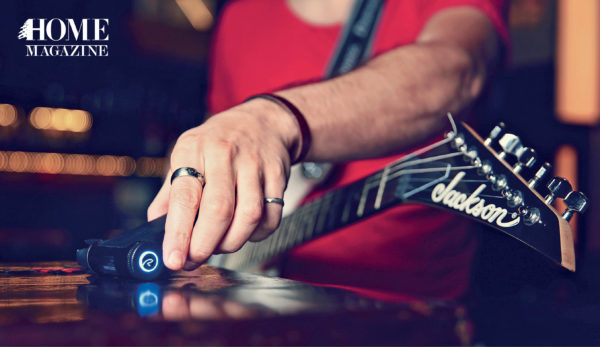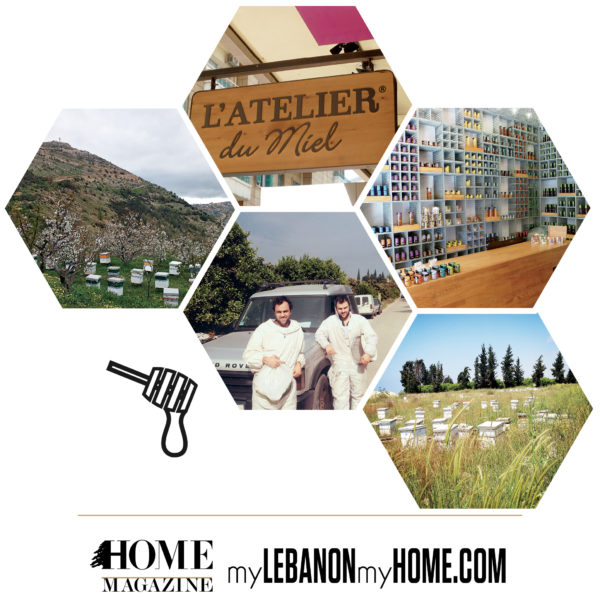Lebanese designer Nada Debs’ exploration of her Arab identity shapes her modern Arabesque design.
Lebanese designer Nada Debs has become synonymous with modern Arabesque design, as seen in her prolific range of impeccably made furniture items and HOME accessories. Her astute eye for design, love of craft and strong vision celebrate the best of Arabic style with a fresh minimalist sensibility and have made her a household name.
Debs spoke openly to HOME about her remarkable journey as a professional, a mother and an expatriate Lebanese coming to terms with her Arab identity, and what she has learned along the way.
How did your signature style materialize?
his is something I was seeking myself. I wanted something authentic and Arab. I grew up in Japan, so when I came to Lebanon as an adult, I felt quite lost. I grew up not relating to my Arab identity.
My parents wanted me to study here, so I came to AUB and studied business. That was during the war, so I left and went to the U.S. and studied at the Rhode Island School of Design. After that, I got married and moved to London, then we moved back to Lebanon.
Today, I am here, and I am not sure exactly how I got here. I was designing furniture for clients in London already, but in Lebanon I wasn’t really sure how to start.
What triggered your new start once back in Lebanon?
I asked myself, “What would make me happy?” I had a vision. I imagined myself flying to Paris, opening my laptop and showing a design.
Then I’d go to New York and show someone else. This is what I’ll do, I thought. Later I forgot this idea. Shortly afterwards, I got a call from the royal family of Jordan telling me how much they loved the children’s bedroom I designed for them back in London. They wanted me to do something else for them. Beirut is quite small, so word got around.
I was also doing a more European style marquetry work. (Marquetry is the art of applying pieces of veneer to a structure to form decorative patterns.) Around this time, a friend wanted to open a Lebanese restaurant in London and asked me to do some interior design for it. My first thought was to do something Arabic but modern.
How did you create something modern and Arabic?
I went to Damascus for the first time to see how they do the traditional work. I ended up making some work like that — a few samples at first — and it took on a life of its own.
This traditional work is beautiful, but I couldn’t see it in my HOME. It’s not something we live with, so I wanted to see it in a very simplified way. I told the craftsman, “Just make me a line or a stroke (of the mother of pearl inlay).” He was puzzled and said, “Don’t you want a rose or something more ornate?” I started to make some samples and put them in my HOME in the beginning.
How do you manage to be both an artist and a businesswoman?
Well, with parents that nagged and nagged! (laughs) My family is business oriented. They are in the textile business. However, I managed to make a few things in the beginning and sell them quickly, which allowed me to self-finance.
Initially, I worked from HOME, where I would receive the press and customers. My salon was filled with my samples, and my second bedroom became my office. I didn’t know anything about accounting or about lawyers. It was all foreign to me. I studied business administration in AUB, but it was all theory and not practical.
My parents would ask from the beginning, “Why are you doing this? Are you making a profit?” They are wholesale textile traders, so profit is prioritized. They didn’t understand that my craft takes time to grow, and I’m nurturing a brand. A few years later, at the end of 2003, I opened my first showroom and store in Saifi Village.
So, your family initially didn’t value your work until you generated some money?
Yes. So that was in the back of my mind, annoying me. I guess it is what made me organized and gave me the push I needed.
“I’ve lived in Europe, the U.S. and Asia, so what I found about Lebanon and what makes it unique is that the people have two desirable qualities at the same time: generosity and human warmth.”
What drove you to reinvent yourself when you came back to Lebanon?
I was going through a divorce, and I wanted to prove to myself and to my children that I could do it. Instead of doing coffees and teas, I could actually do something they can be proud of. That was really what drove me.
What did you do to change your business model?
I got some support from the NGO Endeavor Lebanon in order to help restructure my business model. Today, however, I am actually going back to my old model. Instead of the pyramid structure of having the CEO and the COO and so on, it’s more about me and everyone else around me. I prefer a round-table style of management. I need to speak to everyone and have a direct relationship with my staff. This is why I love working with craft; it’s a human spiritual act. This is how I look at my work. I am not simply making furniture, but I am sending a message — a spiritual energy. My biggest compliment is when people tell me they “feel” something.
Did you reconcile with Lebanon?
You know, when I came back the second time and started meeting people, I realized Lebanon is actually very fun. People are so nice and so generous. I’ve lived in Europe, the U.S. and Asia, so what I found about Lebanon and what makes it unique is that the people have two desirable qualities at the same time: generosity and human warmth. For example, in Japan people are very generous but cold. And the other places I’ve lived did not offer these two important elements.
These two qualities I think are what make the energy in Lebanon really powerful. In Lebanon, there is a special joie de vivre!
You just returned from the Gulf. What were you doing there?
I was asked to do a carpet collaboration for the Fatima Bint Mohamed Bin Zayed Initiative that empowers women carpet weavers in Afghanistan. I went to Afghanistan three times to understand the process and to connect with the women. We did a show in Abu Dhabi Art and a show in Dubai Design Week. I am planning to do a show of these carpets here in Lebanon.
Where is Nada Debs sold?
I have my flagship store and international wholesale clients for my furniture and HOME accessories. But 60 percent of my business is making bespoke furniture working directly with interior decorators. I also do a lot of corporate gifts.
Lebanon’s President Michel Aoun, Queen Rania of Jordan, the Ministry of Foreign Affairs in Abu Dhabi — they all order gifts from Nada Debs to present to other heads of state all over the world. I believe it’s because my work represents the modern Arab identity.
Do you follow trends to stay current?
I am not a fashionista, but I pick up on certain trends. For example, when the popular TV drama “Mad Men” was really in, I was inspired by the vintage furniture of the 1960s. I designed a line called “Vintage Meets Arabesque.” I also designed a line last year called “Now and Zen,” which was representative of Japanese anime (animation) culture.
Do you see yourself as a pioneer in modernizing Arabesque designs?
Well, people tell me I am a pioneer. They tell me, “Nada, you paved the way.” The way I applied it was completely new. Coming from Asia where I grew up, I did not have any emotional attachments to the traditional designs. I had a more objective approach, maybe. I said, “Why don’t we just forget this piece and do it like that.” Back then, one would not have dared to change it in such a way because this art form was sacred.
What advice would you give to emerging product designers?
They really need to look at what is already out there because there is so much. They need to listen to what people are looking for because, as designers, they need to be fulfilling a certain need. In my case, it was an identity need. This is why maybe people relate to my work. Our work is emotional and spiritual. At the end of the day, everyone seeks that kind of connection. There are a lot of nice things out there, but I think it’s the energy of the craftsmen that they feel. Doing things with integrity. You can’t really explain it.
For more info: https://www.nadadebs.com/en/home



































